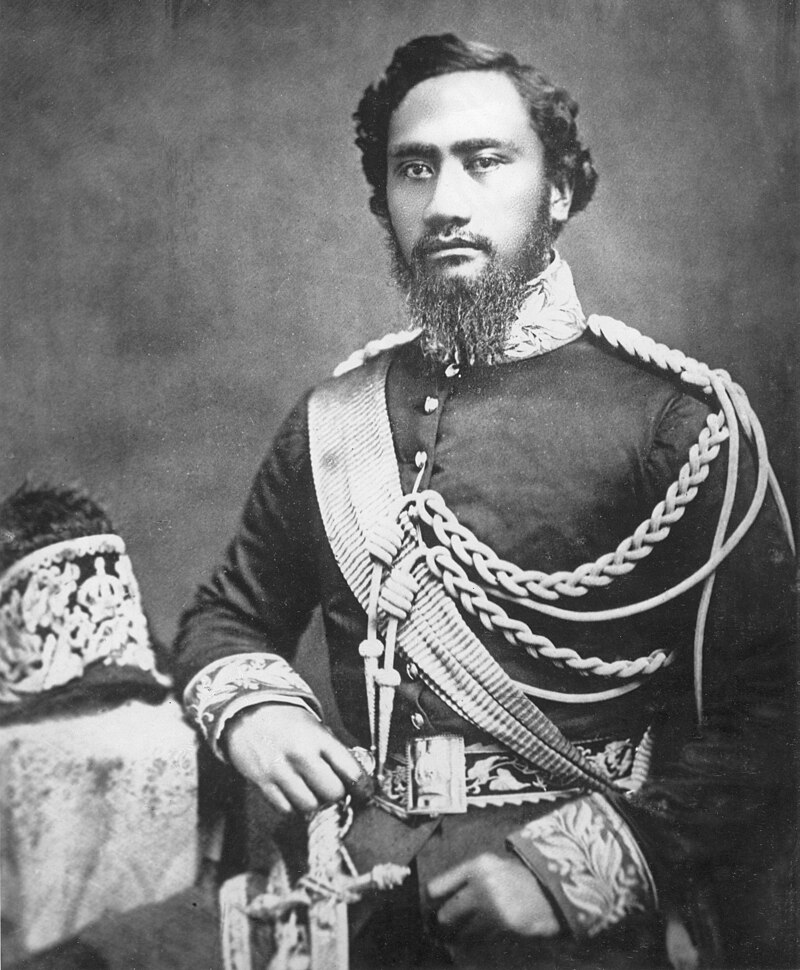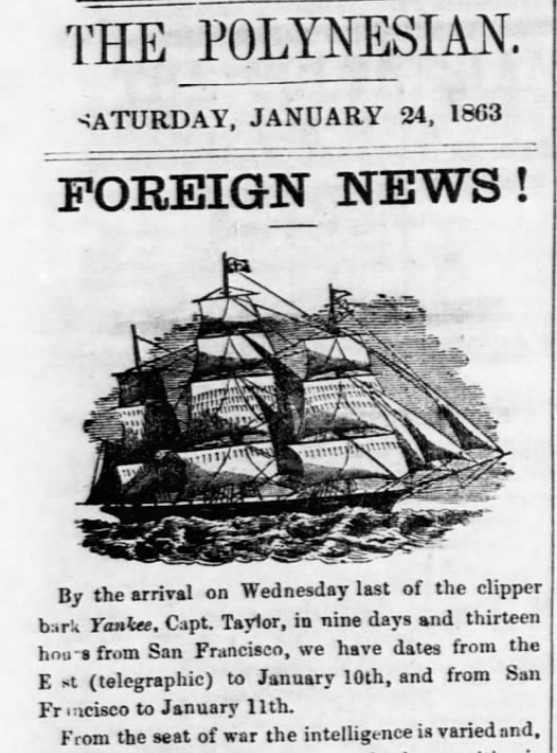The Kingdom of Hawaii and the American Civil War
In this past week, I’ve been following reports of the terrible fires on the island of Maui in Hawaii. My thoughts and prayers are with those who have lost so much and for the first responders and relief volunteers trying to bring help and closure in this difficult period.
Some of the reporting has mentioned the destruction of the historic town of Lahaina, once the capital of the kingdom. Here, 19th Century homes, a court house, and other historic structures have been destroyed or badly damaged by the flames. (See this article from Art News.) While the historic and cultural loss is significant, it pales in comparison to the fires’ death toll which continues to rise, even as I write this on Thursday evening. Some of the interviews I’ve watched are so heartbreaking, others are inspiring with residents’ hopes to rebuild and conquer. A wonderful, resilient, courageous spirit of the community.
Sitting in Virginia, I am thousands of miles from Hawaii. During the Civil War, soldiers and United States political leaders were also thousands of miles away from the royalty of the Kamehameha Dynasty that ruled Hawaii and the native people who lived on the volcanic islands in the tropics. I wondered if Hawaiians and Americans had shared historic moments that tied to Civil War history. The short answer is yes. The longer answer fills essays, but here are a few notes written with thoughtful intention and the hope of aloha (greeting with love) for Hawaii’s rebuilding future.
N? Moku o Hawaii – the native words. The Sandwich Islands – the name given in the 18th Century by an English explorer. Both names were used during the 1860s to describe the eight major volcanic islands in the Pacific, located nearly 2,500 miles southwest of the California’s coastline. “Hawaii” was used by the inhabitants of the islands, the royalty, and on official government documents issued before traveling abroad. Foreigners (including citizens of the United States) tended to use the phrase “The Sandwich Islands.” The United States’ annexation of the Hawaiian Islands did not occur until 1898, followed by territory status in 1900. The territory became state on August 21, 1959. Thus, a formal connection between Hawaii and the United States did not exist during the American Civil War years (1861-1865). However, Hawaiians and 19th Century Americans were in contact and followed each others’ news.
News about the “Sandwich Islands” is not infrequent in newspapers of the United States during the Civil War years. A lot of the printed stories appear to be tales from American missionaries or missionary societies who had an active presence on the islands by the 1860s. Some reports circulated on the mainland about decrees from King Kamehameha IV and King Kamehameha V. Meanwhile, newspapers on the Hawaiian islands printed news about the American Civil War and politics. One particularly interesting edition of The Polynesian was published on January 24, 1863 and included the following notice under the heading Foreign News! “By the arrive on Wednesday last of the clipper bark Yankee, Capt. Taylor, in nine days and thirteen hours from San Francisco, we have dates from the East (telegraphic) to January 10th, and from San Francisco to January 11th.” The column continued with brief details about the Army of the Potomac after the battle of Fredericksburg, reports of the battle of Stone’s River, movements toward Vicksburg, a reprinting of the Emancipation Proclamation, news from the U.S. Congress, news from the Confederate capital, Richmond, and some additional state and other international news from Europe.
During the early 1860s, the Kingdom of Hawaii faced political change and challenge, though not as bloody as the United States. King Kamehameha IV ruled from 1855 until his sudden death in 1863. He pursued diplomatic efforts and prevented the United States from annexing his kingdom in the 1850s and also kept the French and British empires at bay. With the encouragement of his wife and queen, Emma Rooke—who was Hawaiian but raised by adoptive British parents—he tried to bring better medical care to the islands, seeking ways to relief the suffering caused by leprosy and influenza epidemics. Following King Kamehameha IV’s death, his brother took the throne and reigned until 1872, known for his steadiness and lack of pretention. Kamehameha V oversaw the writing of a new constitution for the kingdom, revived traditional island beliefs and practices, and encouraged international tourism to the islands.

Since the first recorded European contact at the Hawaiian islands in the late 18th Century and placement on navigational maps, the islands had attracted adventurers and become an important stopping point for whaling voyages in the early 19th Century. Ships of the United States navy also anchored in the ports to take on provisions or refit. Through this maritime “opening” of the island, some Hawaiians decided to seek employment or adventure beyond their islands, often joining ships’ crews and sailing the world. Some arrived, stayed, and immigrated into the United States, often in the seaboard communities on the West and East Coasts. Some Hawaiians served the United States Navy or enlisted in the ranks of USCT regiments.
Hawaii officially declared neutrality in the American Civil War, a testimony to the kingdom’s trade and maritime importance. As Confederate commerce raiders attacked merchant and whaling ships, some vessels in the Pacific tried to fly a Hawaiian flag in an effort discourage an attack. Casualties and damaged ships from encounters with the CSS Shenandoah limped to Hawaiian port on a couple of occasions.
Although Hawaii did not become a state of the United States until nearly a century after the Civil War, this island kingdom followed the divisive conflict on the North American mainland and took measures to try to ensure their safety and independence. Some Hawaiians who traveled globally and had settled in the United States took part in the Civil War in personal ways, sometimes fighting in the ranks or on the seas. Certainly there are more details to be discovered about Hawaii’s location and the Civil War’s reach into the Pacific.
These resources may be of further interest:
- World History Connected “The Effects of the American Civil War on Hawai’i and the Pacific World” – University of Illinois Press
- They Also Served: Chinese, Southeast Asians, and Hawaiians in the American Civil War – ConnecticutHistory.org
- Information about Servicemen from Hawaii during the American Civil War – National Park Service
- Native Hawaiian Sons of the Civil War – Hawaiian Public Radio

Mahalo and E Komo Mai
The question of Hawaiian registration of merchant ships was an issue, but the Kingdom lacked the means to enforce its sovereignty against the CSA. The war did end the business of supplying the American whaling fleet requiring something to replace it. That something might be sugar, as the north was cut off from southern supplies creating a market, though getting to market was no easy feat. But the end of the war brought depression in the industry, and that brought the decades-long project to seek “reciprocity” tariffs that would allow importation of Hawaii sugar tariff-free. In return for a treaty, the Kingdom gave the US rights to develop Pearl Harbor.
Today is Admission Day holiday.
What an interesting point to consider! Thanks for adding it to the discussion.
Lahaina was a primary port for the huge American Pacific whaling fleet and a stop for the U.S. Navy. Whalers and whaling profits generated much exploration and charting of the Pacific including several major navy expeditions. Some officers on those expeditions played significant roles on both sides of the war, one of whom was responsible for sending the CSS Shenandoah there in 1865. Many Hawaiians and other Pacific islanders also were employed as sailors in the whalers and on warships, including the Shenandoah. Whaling was America’s first world-wide industry and one of the most profitable although it was beginning to decline by midcentury.
Dwight, I was sure you would add some excellent maritime history to the discussion. Thank you for this reminder about the whaling fleet and their connection to the islands. Fascinating to explore!
Sarah, thank you for the summary of an episode of Hawaiian history. While doing some research for my next novel, I learned that King Kalakaua (David) toured the world in 1881. Kalakaua was a distant cousin of kings Kamehameha IV and Kamehameha V. Kalakaua’s trip included stops in Yokohama, Cairo, Lisbon, and San Francisco. He was elected king when another distant cousin, King Lunalilo, died in 1874. The 15 October 1881 “Stockton Mail” introduced King Kalakaua to its readers (https://cdnc.ucr.edu/?a=d&d=SM18811015.1.3&srpos=6&e=, page 3). My grandmother was born there so I’ve always had an interest in the territory and kingdom. God bless the people as they recover from this disaster.
How interesting! Thank you for sharing, and best wishes for your next novel.
There is an interesting and tragic link between fire in Hawaii and the Civil War … Honolulu’s first president of its Board of Health was an “island boy” and son of Protestant missionaries, Nathanial Bright Emerson … born on Oahu in 1839, Emerson was a medical student in Boston when the war started … he enlisted in the 1st Massachusetts Infantry and served as a private … wounded three times, Emerson was discharged in 1864 and finished medical school … he practiced at Bellevue Hospital in NYC and returned to the islands in 1878.
When the bubonic (black) plague struck the islands in 1899, Emerson was “drafted” to help combat the disease … knowledge of how the plague spread (by rats carrying the disease) was not yet understood and the state-of-the-art remedy was palliative care, quarantine, and burning the homes and businesses of plaque victims.
In January 1900, after 41 successful controlled blazes, high winds from the mountains spread a fire beyond the firefighter’s ability to contain it … the fire burned for 17 days and destroyed 38 acres of Honolulu … 7000 residents, almost exclusively Chinese and Japanese, were left homeless … the disease and the fire claimed 62 victims.
For the reminder of his life, Emerson was an historian of Hawaiian culure and writer of Hawaiian mythology … he died in 1915.
Thank you for sharing this story. What an interesting connection from Civil War history and in humanitarian history, too.